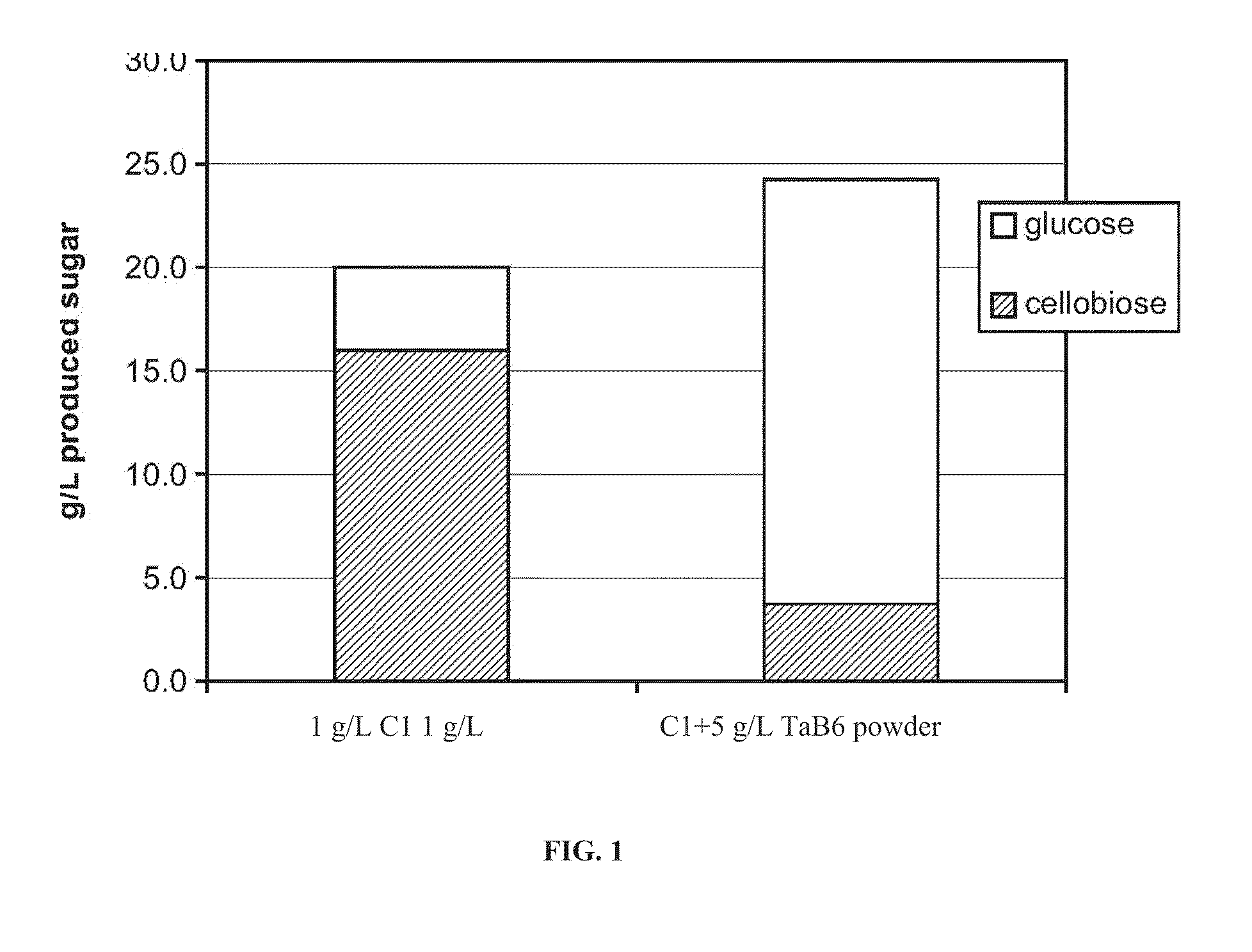Recombinant thermoascus aurantiacus beta-glucosidase variants for production of fermentable sugars from cellulosic biomass
a technology of thermoascus aurantiacus and recombinant glucosidase, which is applied in the field of expression of recombinant glucosidase variants, can solve the problem of difficult conversion of cellulosic biomass into fermentable sugars such as glucos
- Summary
- Abstract
- Description
- Claims
- Application Information
AI Technical Summary
Benefits of technology
Problems solved by technology
Method used
Image
Examples
example 1
Wild-type T. aurantiacus Bgl1 Gene Acquisition and Construction of Expression Vector
[0168]The secreted form of the T. aurantiacus Bgl1 protein (“Bgl1 WT”; SEQ ID NO:2) was used to design a synthetic nucleotide sequence based on codon selection from a merged S. cerevisiae and P. pastoris codon bias table and excluding BamHI, SalI, SfiI, BglI, NgoMIV, and SpeI restriction sites. In addition, an amino terminal methionine residue was added (“Bgl1 WTM”; SEQ ID NO:4). The Bgl1 WTM encoding sequence was synthesized by Gene Oracle and expression constructs were prepared in which the Bgl1 WTM sequence was linked to a yeast or fungal signal peptide appropriate for secretion in S. cerevisiae. The signal peptide sequences were added by PCR primer overlap extension. The Bgl1 construct was cloned into a pYT72 shuttle vector (i.e., pBS24Ub modified so that transcription is under the control of an S. cerevisiae adh2 promoter; See e.g., Sabin et al., BioTechnol., 7:705 [1989]).
[0169]S. cerevisiae ce...
example 2
Production of β-Glucosidase Powders—Shake Flask Procedure
[0170]A single colony of S. cerevisiae containing a plasmid encoding Bgl1 WTM was inoculated into 3 ml of synthetic defined medium containing 60 g / L glucose, 6.7 g / L yeast nitrogen base, 5 g / L ammonium sulfate, and 2 g / L amino acid drop-out mix minus uracil (USBio #D9535). Cells were grown overnight (at least 16 hrs) in an incubator at 30° C. with shaking at 250 rpm. Then, 1 ml of this culture was diluted into 25 ml synthetic defined medium containing 20 g / L glucose, 6.7 g / L yeast nitrogen base, 5 g / L ammonium sulfate, and 2 g / L amino acid drop-out mix minus uracil (USBio #D9535) in a 250 ml flask. This culture was incubated for 72 hours at 30° C., while shaking at 250 rpm. Cells were harvested by centrifugation (3000×g, 15 minutes, 5° C.). The supernatant was decanted into a new tube and concentrated 10 fold using a centrifugal concentrator (VIVASPIN20; Sartorius). The activity of the WTM Bgl1 was confirmed using pNPG (p-nitr...
example 3
Assays to Determine β-Glucosidase Activity
[0171]This Example describes three assays used to determine the presence or activity of β-glucosidase.
A. 5-bromo-4-chloro-3-indolyl-beta-d-glucopyranoside (X-glu) Assay
[0172]Petri plates containing Synthetic Defined medium (SD-ura; comprising 20 g / L glucose, 6.7 g / L yeast nitrogen base, 5 g / L ammonium sulfate, 2 g / L amino acid drop-out mix minus uracil (USBio D9535), 15 g / L agar and 40 mg / L 5-bromo-4-chloro-3-indolyl-beta-d-glucopyranoside) were made. S. cerevisiae containing a plasmid with the bgl1 gene were plated onto these plates and incubated at 30° C. for 3 days. All of the colonies observed in the plates turned a blue color, indicating that organisms were producing an active β-glucosidase which hydrolyses the X-glu to release a chromophore. The negative control consisting of S. cerevisiae transformed with an empty vector produced white colonies.
B. Para-nitrophenyl Glucoside (pNPG) Assay
[0173]In a total volume of 100 μl, 30 μl concentr...
PUM
| Property | Measurement | Unit |
|---|---|---|
| Fraction | aaaaa | aaaaa |
| Volume | aaaaa | aaaaa |
| Cell angle | aaaaa | aaaaa |
Abstract
Description
Claims
Application Information
 Login to View More
Login to View More - R&D
- Intellectual Property
- Life Sciences
- Materials
- Tech Scout
- Unparalleled Data Quality
- Higher Quality Content
- 60% Fewer Hallucinations
Browse by: Latest US Patents, China's latest patents, Technical Efficacy Thesaurus, Application Domain, Technology Topic, Popular Technical Reports.
© 2025 PatSnap. All rights reserved.Legal|Privacy policy|Modern Slavery Act Transparency Statement|Sitemap|About US| Contact US: help@patsnap.com

